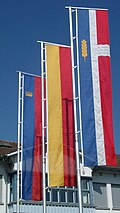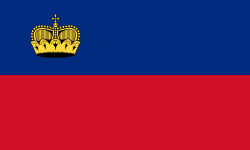 | |
| Use | National flag and ensign |
|---|---|
| Proportion | 3:5 [1] |
| Adopted | 30 June 1982 |
| Design | A horizontal bicolour of blue and red, charged with a gold crown in the canton |
 | |
| Use | State flag and ensign |
| Proportion | 3:5 [1] |
| Adopted | 1982 |
| Design | A horizontal bicolour of blue and red, charged with the coat of arms in the center |
 | |
| Use | Civil flag and ensign |
| Proportion | 3:5 [1] |
| Adopted | 1921 |
| Design | A horizontal bicolour of blue and red |
The national flag of the Principality of Liechtenstein (German : Flagge Liechtensteins) consists of two horizontal bands, one blue and one red, charged with a gold crown in the canton. In use since 1764 and officially enshrined into the nation's constitution in 1921, it has been the flag of the principality since that year. The crown was added to the flag in 1937, after the country discovered at the Summer Olympics held the previous year that their flag was identical to the Haitian civil flag. A design with a modified crown was adopted on 30 June 1982 [2] .







































